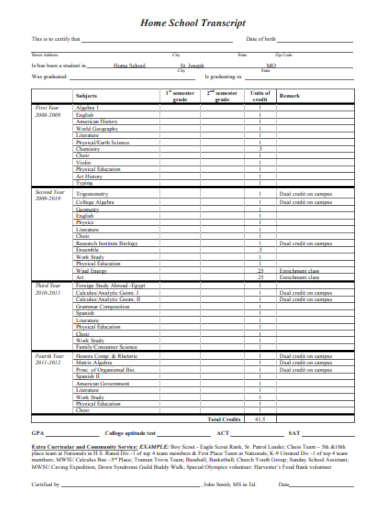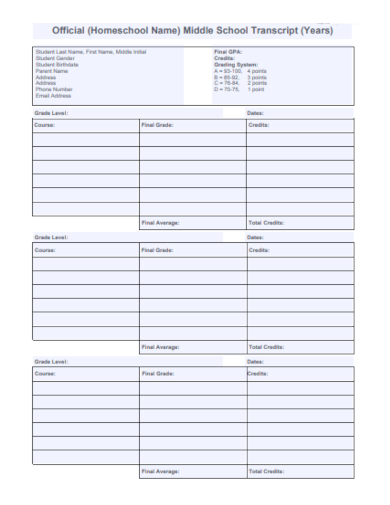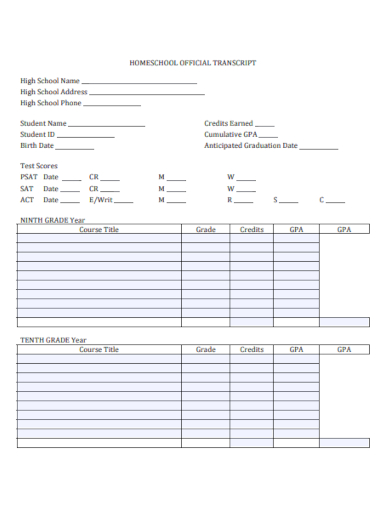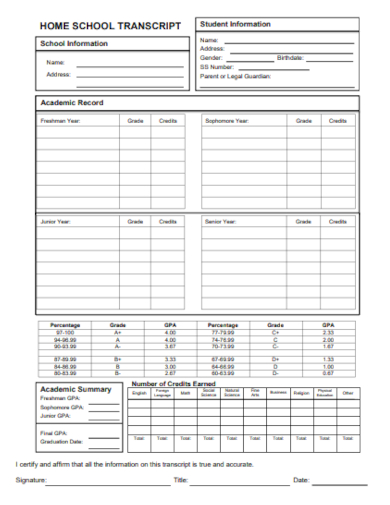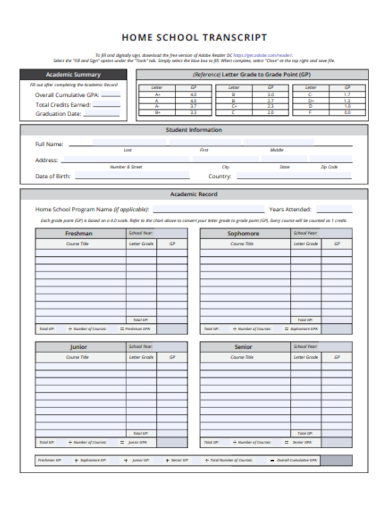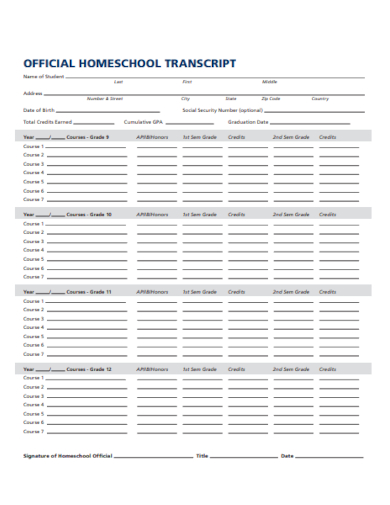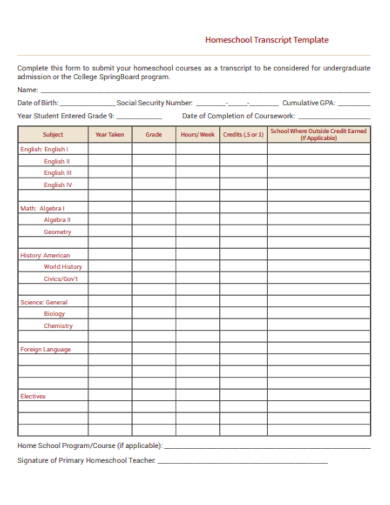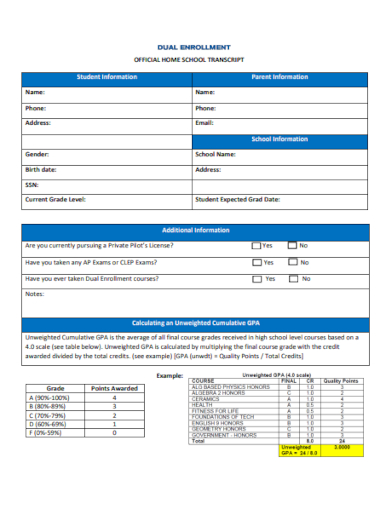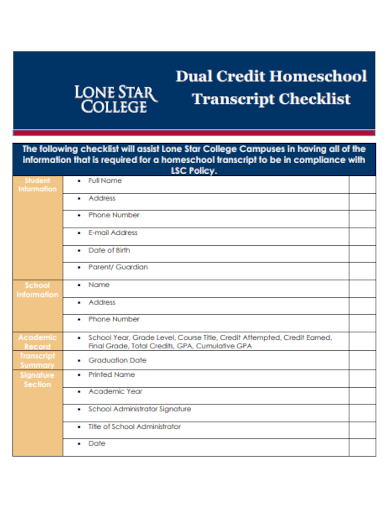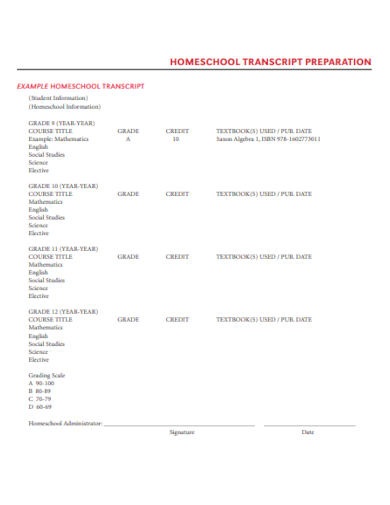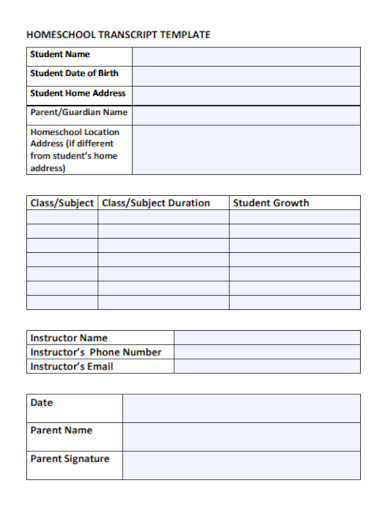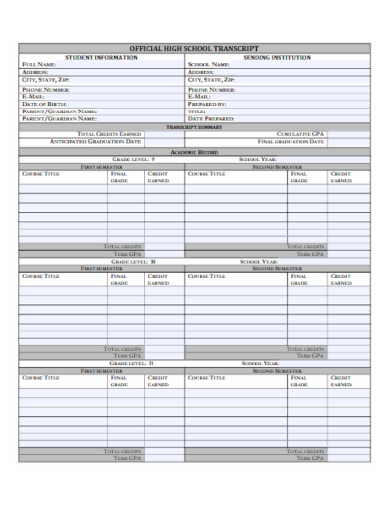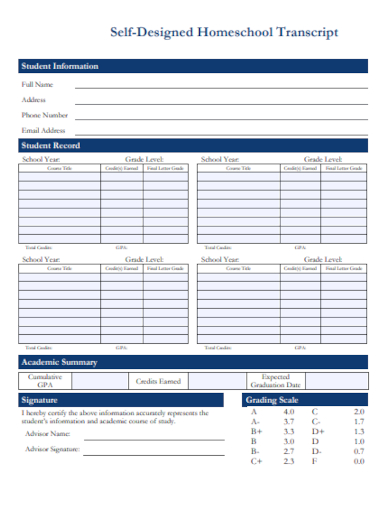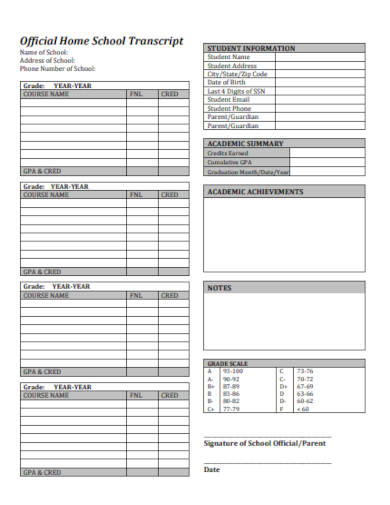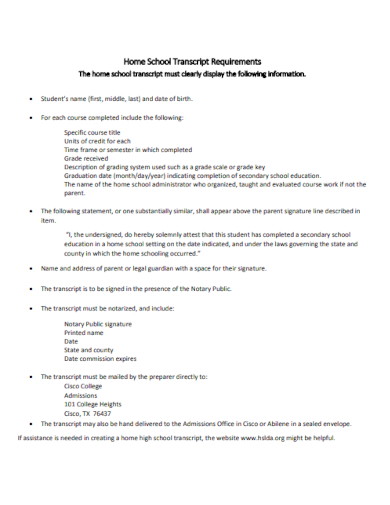Your Ultimate Homeschool Resource Dive into our sample homeschool transcript template, meticulously designed to empower you in creating an exceptional high school transcript. Tailored for homeschooling families, this resource simplifies the process of documenting academic achievements and extracurricular activities. Whether you’re preparing for college admissions, scholarship applications, or maintaining comprehensive records, our guide is your key to success. Join us in crafting a standout home school transcript and opening doors to future opportunities!
20+ Homeschool Transcript Samples
1. Homeschool Transcript Template
2. Printable Homeschool Transcript
3. Homeschool Middle School Transcript
4. Homeschool High School Transcript
5. Sample Homeschool Transcript
6. Editable Homeschool Transcript
7. Elementary Homeschool Transcript
How do I make a homeschool transcript?
Creating a homeschool transcript is an essential task for homeschooling parents when their child reaches high school or plans to apply to college. A transcript serves as an official record of your child’s academic achievements and helps colleges assess their qualifications. Here’s a step-by-step guide on how to create a homeschool transcript:
Gather Necessary Information:
Collect all relevant academic records, including course titles, grades, and credits earned. Make sure you have a comprehensive record of your child’s high school years.
Choose a Transcript Format:
Decide on the format you want to use for the transcript. Common formats include GPA-based transcripts and narrative transcripts. Be sure to check the requirements of the colleges your child plans to apply to and choose a format that aligns with their expectations.
Create a Header:
At the top of the transcript, include your child’s full name, date of birth, address, phone number, and email. If your homeschool has a name, you can include that as well.
List Courses and Grades:
Create a table or list that includes the names of all the courses your child has completed. Alongside each course, note the grade earned and the number of credit hours awarded. You can use a grading scale (e.g., A=4.0, B=3.0) to determine the GPA if applicable.
Calculate GPA:
If your transcript includes a GPA, calculate it based on the grades earned in each course. Total the grade points and divide by the total number of credits to determine the GPA.
Include Extracurricular Activities:
Highlight any extracurricular activities, clubs, sports, volunteer work, or special projects your child has been involved in. This demonstrates a well-rounded education.
Write a Transcript Summary:
Craft a brief summary or letter explaining your homeschooling approach, curriculum choices, and any unique learning experiences your child has had. This helps admissions officers understand your educational philosophy.
Obtain Signatures if Required:
Some colleges may require the transcript to be signed or notarized. Check the specific requirements of the institutions your child is applying to.
Proofread and Format:
Ensure the transcript is well-organized and free of errors. Use a clean and professional format. You can find transcript templates online or create your own using word processing software.
Keep Records:
Make copies of the transcript for your records and store them securely. You may need them for scholarship applications or future reference.
Submit the Transcript:
When applying to colleges, follow their submission guidelines carefully. Some may accept electronic transcripts, while others may require physical copies. Be aware of deadlines and ensure your transcript reaches the admissions offices on time.
Creating a homeschool transcript can seem like a complex task, but with careful record-keeping and attention to detail, you can provide colleges with an accurate representation of your child’s academic achievements. It’s essential to start early and stay organized throughout your child’s high school years to ensure a smooth transition to higher education.
8. Official Homeschool Transcript
9. Blank Homeschool Transcript
10. Dual Enrollment Homeschool Transcript
11. College Homeschool Transcript Checklist
12. 9th Grade Homeschool Transcript
13. 12th Grade Homeschool Transcript
14. Academic Course Homeschool Transcript
15. Homeschool Subject Transcript
Why Do Homeschool Students Need a Transcript?
Homeschool students often need a transcript for several important reasons, despite not attending traditional schools. A well-prepared homeschool transcript serves as a crucial document that showcases a student’s academic achievements, extracurricular activities, and overall preparedness for higher education or other post-graduation opportunities. Here are several reasons why homeschool students need a transcript:
College Admissions:
One of the primary reasons homeschool students require a transcript is for college admissions. Most colleges and universities, whether they are traditional or online institutions, require transcripts as part of the application process. A transcript allows admissions officers to evaluate a student’s academic readiness and suitability for their programs.
Scholarships and Financial Aid:
Many scholarships and financial aid programs, both merit-based and need-based, require transcripts to assess a student’s eligibility. Scholarships often consider a student’s academic achievements, extracurricular involvement, and community service, all of which are typically included in a transcript.
Accreditation:
Homeschooling laws and regulations vary by location, and some states or regions may require homeschooling families to maintain an accredited transcript. An accredited transcript can demonstrate that a student’s education meets specific standards set by educational authorities.
Competitive Advantage:
In a competitive college admissions landscape, a well-organized homeschool transcript can provide an advantage. It allows students to highlight their unique educational experiences, such as specialized coursework, individualized learning plans, or apprenticeships.
Job Applications and Interviews:
While not as common as college admissions, some employers may request transcripts, especially if they are looking for evidence of specific skills or coursework relevant to the job. A transcript can provide additional credibility to a homeschool graduate’s qualifications.
Trade Schools and Vocational Programs:
Homeschool students interested in trade schools, vocational programs, or specialized training institutes may also need transcripts. These institutions often require transcripts to assess a student’s readiness for their specific programs.
Personal Records and Self-Assessment:
Beyond external requirements, a homeschool transcript can serve as a valuable record for the student and their family. It provides a clear overview of the student’s educational journey, making it easier to assess progress and identify areas for improvement.
Homeschool Associations and Co-ops:
Some homeschool associations or co-op programs may request transcripts to ensure that students meet their academic standards and requirements for participation.
In summary, a homeschool transcript is a critical document that not only meets external requirements but also serves as a reflection of a student’s educational journey and accomplishments. It plays a pivotal role in opening doors to various educational and career opportunities and helps homeschool students compete on an equal footing with their traditionally schooled peers. Homeschooling families should invest time and effort in creating a well-documented and organized transcript to ensure their child’s success in the next phase of their educational journey.
16. Homeschool Transcript Form
17. Public Homeschool Education Transcript
18. Homeschool Semester Transcript
19. Homeschool Transcript in Word
20. Homeschool Attendance Transcript Form
21. Home School Transcript Requirements
What Is Included on a Homeschool Transcript?
A homeschool transcript is a formal record of a student’s academic achievements and other relevant information. It is typically required when a homeschooled student applies for college, scholarships, or other educational opportunities. While the specific content of a homeschool transcript can vary, it generally includes the following key components:
Student Information:
Full legal name of the student.
Date of birth.
Homeschool name or affiliation (if applicable).
Contact information (address, phone number, and email).
Academic Coursework:
A list of all courses completed during the high school years. Include both core subjects (e.g., math, science, English, history) and elective courses.
Course titles: Clearly state the name of each course.
Course descriptions (optional): Briefly describe the content and objectives of each course.
Grade received for each course: Use a traditional grading scale (e.g., A, B, C) or a numerical equivalent (e.g., A=4.0, B=3.0).
Credits earned: Indicate the number of credits awarded for each course. Credits are typically based on the amount of time or
effort devoted to the course.
Grade Point Average (GPA):
Calculate and display the student’s cumulative GPA, typically on a 4.0 scale.
Some transcripts also include weighted GPAs for honors or advanced courses.
Standardized Test Scores:
Include scores from standardized tests such as the SAT or ACT, if applicable.
Note any other relevant test scores, like Advanced Placement (AP) exams or SAT Subject Tests.
Extracurricular Activities:
List any extracurricular activities, clubs, sports, or organizations the student participated in during high school.
Highlight leadership roles or significant accomplishments within these activities.
Awards and Honors:
Mention any academic awards, honors, or recognition received during high school.
Volunteer Work and Community Service:
Describe any community service or volunteer work completed during high school, emphasizing its significance.
Transcript Summary or Cover Letter
Optionally, include a transcript summary or cover letter that provides context for the transcript. This can explain your homeschooling approach, curriculum choices, and any unique educational experiences.
Date of Graduation:
Specify the date of the student’s high school graduation.
Signature and Certification:
The transcript may require a signature or certification by a homeschooling parent or administrator.
It’s important to note that homeschool transcripts can vary in format and style. Some families create detailed transcripts with comprehensive course descriptions, while others use a more straightforward format. The content and presentation should align with the requirements of the colleges or institutions to which the student is applying. Additionally, some states or regions may have specific guidelines or regulations for homeschool transcripts, so it’s advisable to check local requirements when creating one.
Related Posts
FREE 10+ Plagiarism/Cheating Policy Samples in MS Word | PDF
FREE 10+ Professional Boundaries Policy Samples in PDF
FREE 10+ Charter Document Samples in MS Word | PDF
FREE 10+ Related Personnel Policy Samples in MS Word | PDF
FREE 10+ Tuition Payment Policy Samples in PDF | MS Word
FREE 10+ Suspension And Expulsion Policy Samples in MS Word | PDF
FREE 10+ Class Syllabus Samples & Templates in MS Word | PDF
FREE 10+ Student Travel Policy Samples in MS Word | Google Docs | Pages | MS Outlook | PDF
FREE 10+ Alternative Dispute Resolution Samples in MS Word | PDF
FREE 10+ Program Description Samples in PDF | MS Word
FREE 10+ High School Scholarship Program Samples in PDF
FREE 10+ Uniform Complaint Policy and Procedure Samples in PDF
FREE 10+ Bullying Policy Samples in MS Word | PDF
FREE 10+ Fiscal Control Policy Samples & Templates in MS Word | PDF
FREE 10+ Cooperative Policy Samples & Templates in MS Word | PDF


